Did you ever take a moment to consider how good Google has gotten at providing us with instant answers? Remember how SERPs looked fifteen years ago?
These days, search results pages are filled with interactive, featured snippets like how-to’s, cooking recipes, product prices, reviews, and more. It’s almost as if clicking the blue links was optional.
These improved search results are possible thanks to the joint effort by the search engines and web developers. Google wouldn’t be able to come up with these precise answers and serve them to users so quickly without structured data.
What is structured data?
Most popular structured data markup is Schema.org.
How do you use structured data?
Why does a website need structured data?
Structured data is a technology deeply connected to the idea of the Semantic Web. Introduced by Tim Berners-Lee, the inventor of the World Wide Web, the Semantic Web was supposed to be the next stage of web evolution, after it had become interactive with the introduction of RSS and AJAX.
Berners-Lee had a vision for “a web of data that can be processed by machines.” This fascinating idea enticed many supporters in the early 2000s but was also fervently criticized for its’ utopian character.
The history of the Semantic Web has already been well documented. Although captivating at first, it did prove to be too idealistic. Despite various efforts over the years, the project is unlikely to ever emerge the way Berners-Lee proposed.
Structured data, however, the technology that was supposed to make the Semantic Web possible, is highly relevant and continues to be applied in new web features.
Let’s explore how structured data works in practice and take a look at the benefits it comes with. I hope that by the end of the article, it will be evident that structured data doesn’t get the appreciation it deserves.
How to implement the schema.org vocabulary
Schema.org vocabulary can be applied by using several available formats. Some of the most popular formats are JSON-LD, Microdata, and RDFa. Here’s an example of how structured data is used to markup an article:
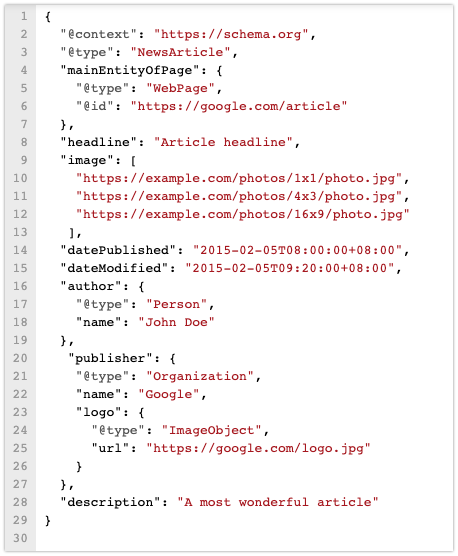
The above example uses the JSON-LD (JavaScript Object Notation for Linked Data) format, which is preferred and recommended by Google. You can find more useful Google tips in their detailed database on structured data before implementing it on your website.
Although it may sound technically challenging, using structured data doesn’t require having to write a single line of code; there are many tools and resources that can make the schema markup process easier.
The Structured Data Markup Helper can be used to automatically add schema vocabulary to your website without any technical knowledge whatsoever.
Let’s use Structured Data Markup Helper to markup some elements within the Ultimate Guide to Crawl Budget we recently posted on our blog.
To markup our page, we must set things up first. I’ll be using the Structured Data Markup Helper to markup a page containing an article.
Then I have to either submit my article’s URL or its HTML code and click Start Tagging.
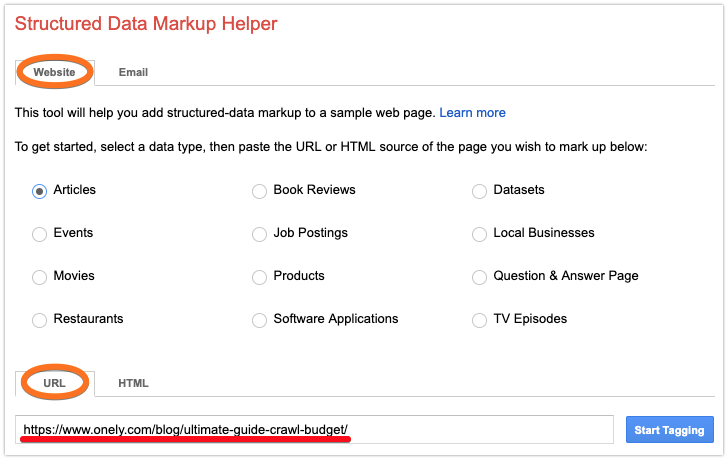
Once in the tagging phase, I select the elements I want to markup and choose the corresponding schema properties from the list (since I’m marking-up an article, the suggested properties include the author, article body, publisher, etc.).
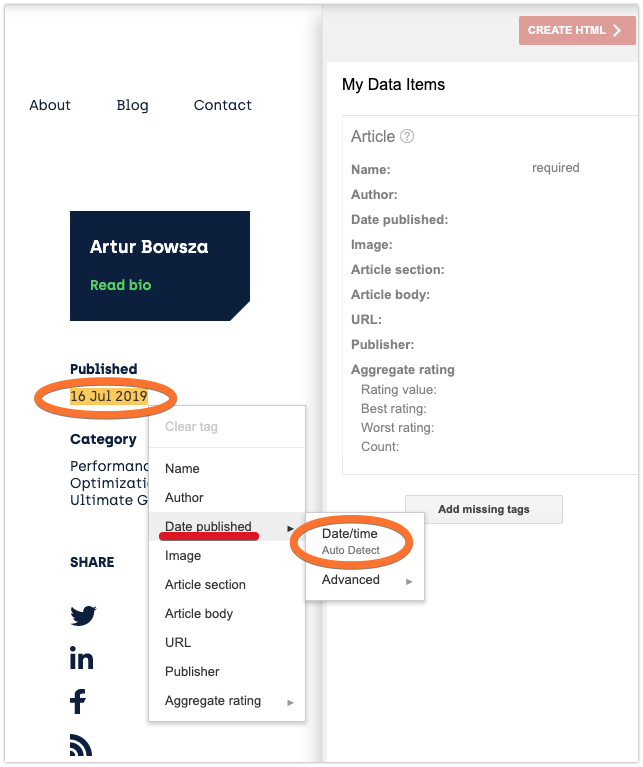
I marked-up the name of the author and the date published. The My Data Items section gets updated immediately, and I can see how many properties I still need to mark-up.
I’m finished, for now, so I click the Create HTML button, and the generated JSON-LD code appears. I can then either copy and paste it or download an HTML file generated by the tool.
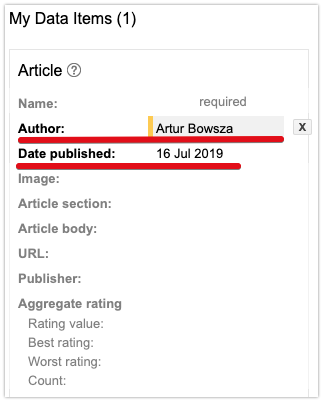
After you use the generated code to markup your page, it’s time to test it! An excellent tool for testing structured data is the Rich Results Test.

You can use it to submit your page’s URL and check if it’s eligible for displaying rich results. Alternatively, you can submit only the code snippet you want to test. Rich Results Test also gives you a preview of what your rich snippet might look like in the search results.
Even if your structured data is marked up correctly from a technical point of view, there is no guarantee that your website will display rich results. If you are hoping to have your structured data used by the search engine, you need to follow the structured data guidelines. Be sure to get familiar with those!
For instance, Google won’t display any rich results which are not relevant to the website’s content, like when a furniture e-commerce store is labeling their product info as cooking recipes. It’s also recommended to include all the necessary properties of a given schema.
Keep in mind that, ideally, every page of your website should be individually marked up. Avoid copying markup from one page and using it elsewhere, except for canonical pages, which should all be marked up with the same code.
What you can gain by using schema
If the crawlers understand your content, they will show it to the right audience
Structured data implementation is not a direct factor in Google’s ranking system. However, John Mueller, a senior webmaster at Google, pointed out on Twitter that, since using structured data makes a website easier to understand for the search engine, it can improve your ranking for specific keywords and help you target the right audience.
There's no generic ranking boost for SD usage. That's the same as far as I remember. However, SD can make it easier to understand what the page is about, which can make it easier to show where it's relevant (improves targeting, maybe ranking for the right terms). (not new, imo)
— John Mueller (official) · #StaplerLife (@JohnMu) April 2, 2018
Rich results lead to more traffic and conversions
Using schema markup is a must if you want to have rich results appear on the search engine results page.

The rich results shown above consist not only of the blue link and the meta description of the page but also of a highlighted photo and user rating (in this case, of a vegan kebab recipe. If you didn’t know that’s a thing, well, there you go).
For webmasters, these additional snippets within search results provide a unique opportunity. A colorful photo with a high user rating displayed next to your blue link is undoubtedly more appealing than a regular blue link in the search results.
Other rich results types may expand the user experience in different ways. For example, if you visit a website with a marked-up event described, you may be able to export the information directly to your calendar. Local Business Listing markup can make it easier to contact the business you were looking for.
Showing rich results is known to increase the clickthrough rate, organic traffic, and other performance aspects. Google published several case studies which documented how rich results have a positive influence on various KPIs. One domain noted as much as a 100% year-to-year increase in organic traffic after implementing schema markup! Others have seen considerable increases in their conversion or time-on-page metrics.
Imagine how much you have to lose if the pages you compete with in search results already display rich results, and you are just the boring blue link between them.
Other types of structured data
Schema.org is not the only vocabulary that you should use to markup your content. Structured data in RDFa format is supported by leading social media platforms: Facebook and Twitter. Adding markup on your pages, you can influence what is presented when users link to your page on social media.
Here’s some markup that we added to control how a link to our crawl budget article looks like on Facebook. The protocol that Facebook supports is called Open Graph, and you can find all the information necessary for its implementation at ogp.me.
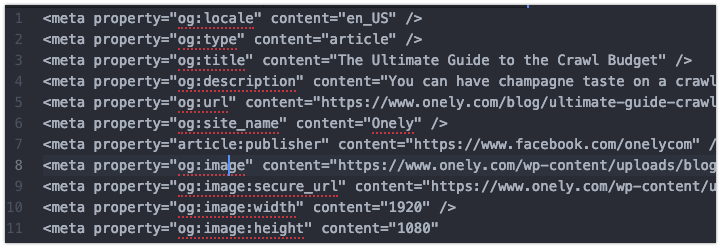
To do the same for Twitter, we used the Twitter Cards protocol:

Why is structured data so important?
Because Google is aiming for a future of the Internet in which content is semantically intelligible for machines.
The Hummingbird update was the beginning of a new era for SEO. For years now, Google has been improving its’ ranking system so that it truly promotes relevance and authority. Striving for a better user experience, they introduced changes which encouraged websites to move away from mindless keyword stuffing, and promote helpful, quality content instead. This involves the use of an indexing system that is able to categorize websites semantically.
Natural language, however, is an ever-evolving system. Its interdependent elements need to be interpreted to decode the message. Explaining these complexities to a computer is a tricky endeavor.
Although Google’s core algorithm is gradually teaching itself to understand our twisted, non-Boolean logic, it is still struggling to categorize ambiguous content without additional information provided. This is where structured data comes in.
Wrapping up
Tim Berners-Lee might have been wrong in his predictions about the semantic future of the web, but search engines found working with structured data a great way to improve the quality of their services.
With every update, Google is advancing its algorithm’s ability to serve accurate, helpful search results. This includes supporting new rich results types as well as getting better at recognizing what indexed websites are about. By using schema, you can make sure that your website is ready to dominate the competition for years to come. If you need help auditing and implementing schema on your website, our technical SEO services entail a thorough audit of your schema usage.
Want to know more about structured data? Then watch my video “Is Structured Data Right for Your Website?“:
Contact us if you need any help optimizing your structured data.








